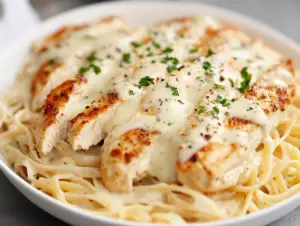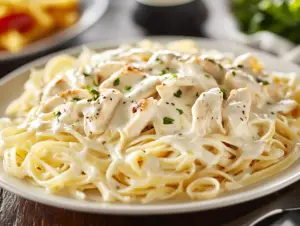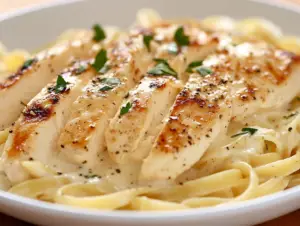Chicken Alfredo is a delicious and comforting dish that many people enjoy. However, one thing often comes to mind when we think about Chicken Alfredo—its high-calorie content. This creamy, rich pasta dish is packed with flavor but also with calories. What exactly makes Chicken Alfredo such a calorie-heavy meal? Let’s break down the dish’s components, explore how each contributes to the calorie count, and discuss healthier alternatives that maintain the savory flavor.
Nutritional Overview of Chicken Alfredo
Chicken Alfredo is made from a few key ingredients that are calorie-dense. These include:
- Fettuccine Pasta: Usually made from refined wheat, this pasta provides a large number of carbohydrates.
- Chicken Breast: A good source of lean protein, though its preparation can add calories.
- Alfredo Sauce: The sauce, made from heavy cream, butter, and Parmesan cheese, significantly raises the dish’s calorie count.
Together, these ingredients make Chicken Alfredo a calorie-dense dish. A typical restaurant portion can range from 1,200 to 1,500 calories per serving, mainly due to the generous use of sauce and pasta. For a more detailed breakdown, you can find nutritional facts for Alfredo sauce here.
Calorie Breakdown of Chicken Alfredo
Here’s a rough estimate of the calories in each component:
- Pasta: One serving (about 2 cups) of fettuccine contains approximately 400 calories.
- Chicken Breast: Grilled chicken breast adds around 200 calories, depending on how it’s cooked.
- Alfredo Sauce: This is where the bulk of the calories lie. Half a cup of Alfredo sauce contributes roughly 500 to 600 calories, largely from the fats in the cream and butter.
For more insights into calorie content in creamy pasta dishes, you can explore this calorie guide.
Alfredo Sauce: The Main Calorie Contributor
Alfredo sauce, with its rich and creamy texture, is the most significant calorie source in Chicken Alfredo. It’s typically made from heavy cream, butter, and Parmesan cheese, all of which are high in fat and calories.
Ingredient Breakdown:
- Heavy Cream: One cup of heavy cream contains around 800 calories and 80 grams of fat, making it a significant contributor to the dish’s calorie content.
- Butter: A tablespoon of butter adds approximately 100 calories and 11 grams of fat.
- Parmesan Cheese: While Parmesan adds flavor, 1/4 cup provides 110 calories and 7 grams of fat.
Each of these ingredients packs a high calorie count, so even a modest amount of Alfredo sauce can raise the dish’s calorie total significantly. Restaurants often use large portions of sauce, leading to even higher calorie counts.
Chicken’s Role in the Calorie Count
Chicken is a lean source of protein, but its preparation method can raise its calorie contribution.
- Chicken Breast: A lean cut, grilled chicken breast adds about 165 calories per 3-ounce serving.
- Chicken Thighs: Thighs contain more fat and calories—around 210 calories per 3-ounce serving. Leaving the skin on or frying increases this number further.
- Cooking Methods: Frying or sautéing chicken in oil or butter can add extra calories. For instance, frying chicken significantly increases its calorie count due to the added fats.
Choosing grilled or baked chicken breast instead of fried chicken or thighs helps lower the calorie count.
Pasta: Carbs and Calories
Pasta is another key calorie contributor in Chicken Alfredo. Fettuccine is a carbohydrate-heavy food that can be calorie-dense, especially when served in large portions.
- Traditional Fettuccine Pasta: A standard 2-cup serving provides around 400 calories. Because restaurant portions are often large, you can easily exceed this amount.
- Portion Control: Larger portions, especially in restaurants, can quickly increase calorie intake.
To reduce calories, consider using whole wheat pasta, which adds more fiber and nutrients, or vegetable-based alternatives like zucchini noodles (zoodles) or spaghetti squash, which drastically reduce calories.
Restaurant vs. Homemade Chicken Alfredo

When you order Chicken Alfredo in a restaurant, you often receive oversized portions along with extra toppings like garlic bread or cheese. This pushes the calorie count of your meal above 1,500 calories. Making Chicken Alfredo at home, on the other hand, lets you control portion sizes and ingredients.
Here are the key differences between restaurant-made and homemade versions:
- Restaurant Chicken Alfredo: Restaurants use more butter, cream, and cheese than homemade versions. Larger portion sizes also contribute to calorie counts that can exceed 2,000 calories when paired with sides like garlic bread.
- Homemade Chicken Alfredo: You can control portion sizes and ingredients at home, reducing the calorie count to around 600-800 calories per serving. Simple substitutions, such as using lighter dairy products or whole wheat pasta, also help.
By making it at home, you can enjoy a lighter version without sacrificing flavor.
How to Make Chicken Alfredo Healthier
You can enjoy Chicken Alfredo without worrying about high calories by making a few smart substitutions. Here are some tips for reducing calories without losing flavor:
Substituting High-Calorie Ingredients:
- Use Lighter Dairy Products: Swap heavy cream for half-and-half, whole milk, or Greek yogurt. These options will keep the sauce creamy while cutting down on calories.
- Replace Butter with Olive Oil: Olive oil contains healthier fats and fewer calories than butter. Reducing butter use helps lower calories and saturated fats.
- Opt for Low-Fat Cheese: Reduced-fat Parmesan or mozzarella cheese works well in the sauce. You can also use nutritional yeast for a cheesy flavor with fewer calories.
Use Alternative Pasta:
- Whole Wheat Pasta: It provides more fiber and nutrients than refined white pasta, keeping you fuller longer.
- Vegetable Noodles: Zucchini noodles or spaghetti squash offer low-calorie, low-carb alternatives to traditional pasta while boosting nutritional content.
Control Portions:
- Serve Smaller Portions: Reducing the amount of pasta and sauce on your plate can make a big difference. Add more vegetables like spinach, broccoli, or mushrooms to bulk up the dish without adding many calories.
- Avoid High-Calorie Add-Ons: Skip extra cheese or garlic bread, which can add hundreds of calories.
Hidden Calories in Chicken Alfredo
When enjoying Chicken Alfredo, you might overlook some hidden sources of calories that can quickly add up, turning the dish into a calorie bomb. These extra calories often sneak in through cooking techniques, add-ons, and ingredient choices. Here are some common hidden calorie contributors:
1. Cooking Oils and Fats
Cooking chicken or vegetables in oil or butter can significantly increase the calorie content. For example:
- Olive Oil: While healthy, 1 tablespoon contains around 120 calories. Many recipes use more than this for sautéing.
- Butter: Just 1 tablespoon adds about 100 calories, and some Alfredo recipes use multiple tablespoons.
If you don’t measure oils and fats carefully, you might be adding several hundred extra calories without realizing it.
2. Extra Cheese
Cheese is a major flavor booster in Chicken Alfredo, but it’s also a source of hidden calories. Sprinkling additional Parmesan or mozzarella on top of the dish can add:
- Parmesan Cheese: 1/4 cup adds approximately 110 calories.
- Mozzarella Cheese: A similar amount can add 80-100 calories, depending on whether it’s full-fat or reduced-fat.
These cheese additions, though small in quantity, can contribute significant calories to an already heavy dish.
3. Garlic Bread and Other Sides
When served in restaurants, Chicken Alfredo often comes with sides like garlic bread, breadsticks, or salads loaded with high-calorie dressings. These sides can add hundreds of calories to your meal. For example:
- Garlic Bread: A single slice can add 150-200 calories, especially if loaded with butter or oil.
- Salad Dressings: Creamy dressings like ranch or Caesar can add an additional 100-200 calories per serving.
While these sides complement the dish, they can significantly increase your calorie intake.
How to Avoid Hidden Calories

Reducing hidden calories in Chicken Alfredo is key to enjoying this dish without consuming excess calories. Here are some practical tips to help you avoid those sneaky calorie culprits:
1. Measure Cooking Oils and Fats
One of the most common sources of hidden calories is the cooking oil or butter used to prepare the dish. To cut back:
- Use non-stick pans: This allows you to cook with less oil, significantly reducing calorie intake.
- Measure your oil: Instead of pouring oil directly into the pan, use a measuring spoon. Stick to 1 tablespoon (about 120 calories) or less.
- Consider alternatives: Use cooking sprays or low-calorie oil substitutes to further reduce calories from fats.
2. Use Cheese Sparingly
Cheese adds flavor, but it’s calorie-dense. Here’s how to limit its impact:
- Measure your portions: When adding cheese, stick to the recipe’s recommended amount and avoid extra toppings.
- Use reduced-fat options: Opt for low-fat Parmesan or mozzarella to cut down on calories while still enjoying the taste.
- Try nutritional yeast: This provides a cheesy flavor with fewer calories, making it a great alternative for flavoring.
3. Watch Portion Sizes
Restaurant portions are often much larger than what you’d serve at home. Here’s how to manage portion control:
- Serve smaller portions: Keep portions of pasta and sauce in check. A good serving size for pasta is 1-2 cups cooked, which helps keep the calorie count lower.
- Fill your plate with veggies: Bulk up your meal with non-starchy vegetables like broccoli, spinach, or zucchini. These will fill you up without adding significant calories.
4. Skip High-Calorie Sides
Common sides like garlic bread or creamy salads can quickly add hidden calories. Avoid them by:
- Choosing healthier sides: Opt for a light salad with a vinaigrette or steamed veggies instead of garlic bread.
- Making homemade dressings: If you’re adding a salad, make your own light dressing using olive oil, lemon juice, and herbs, which is lower in calories than store-bought creamy dressings.
5. Be Mindful of Add-Ons
Extra garnishes or toppings like additional cheese, sauces, or butter can add unnecessary calories. Avoid sprinkling extra cheese or drizzling oil on top of your meal unless you’ve accounted for it in your calorie goals.
Frequently Asked Questions (FAQs)
Why does Chicken Alfredo have so many calories?
The high-calorie content comes from the Alfredo sauce, which contains heavy cream, butter, and Parmesan cheese. These ingredients are calorie-dense, meaning they add many calories even in small amounts.
Is Chicken Alfredo considered healthy?
In its traditional form, Chicken Alfredo is not considered a health food due to its high fat and calorie content. However, you can make it healthier by using lighter ingredients and controlling portion sizes.
How can I reduce calories in Chicken Alfredo?
To reduce calories, try substituting heavy cream with half-and-half or Greek yogurt, using olive oil instead of butter, and opting for vegetable noodles or whole wheat pasta instead of traditional fettuccine.
How many calories are in a typical serving of Chicken Alfredo?
A restaurant serving of Chicken Alfredo can range from 1,200 to 1,500 calories, depending on portion size and preparation. Homemade versions can be much lower in calories, especially when you use lighter ingredients.
What are some healthy alternatives to Chicken Alfredo?
Healthy alternatives include using whole wheat pasta or vegetable noodles, opting for grilled chicken breast, and making a lighter Alfredo sauce with Greek yogurt or half-and-half.

Conclusion
Chicken Alfredo is a tasty and satisfying dish, but it’s high in calories due to its creamy sauce, pasta, and large portions. With a few substitutions and portion control, you can enjoy a lighter version of this classic meal. Next time you’re craving Chicken Alfredo, try one of these healthier alternatives, and you’ll enjoy the same rich flavors with fewer calories.

